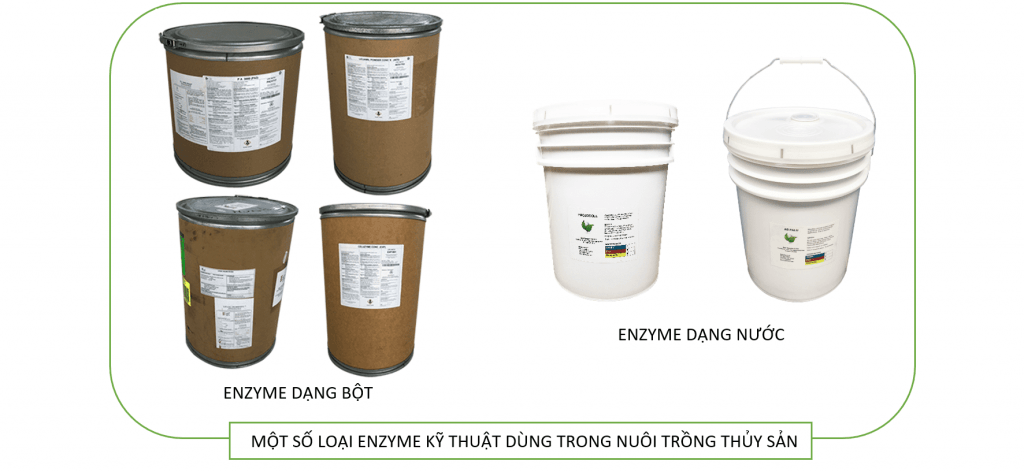APPLICATION OF ENZYME IN AGRICULTURE
Enzyme overview
Enzymes, also known as yeast, are biological catalysts whose basic components are proteins. Enzymes are an essential part of the lives of both humans and other animals. They are widely used in various industries such as detergent production, pharmaceuticals, the paper industry, flour production, milk and cheese processing, beverage production, animal feed production, etc. Besides the industrial benefits, they also have a very important influence on agriculture, especially aquaculture. Enzymes help speed up biochemical reactions for the environment as well as domestic animals, improve environmental factors, improve nutrient absorption for the digestive system, and improve FCR. So, knowing about enzymes will help us understand somewhat about their uses and great benefits when using them properly.
In this article, we only show the applications and benefits of the main types used in agricultural activities to give farmers an understanding of how to apply them effectively.
Technical enzymes commonly used in aquaculture include protease, amylase, lipase, cellulase, and urease.

Applications of enzymes
- Protease also known as peptidase or proteinase, is a proteolytic enzyme, these digestive enzymes break down proteins into amino acids. In addition, they play a role in many body processes, including cell division, blood clotting, and immune function. Protease is a digestive enzyme in the stomach and pancreas in different forms such as Pepsin, Trypsin, Chymotrypsin, etc. They can hydrolyze insoluble proteins, proteins in waste products, to produce solid solutions. or dry solids of nutritional value to fish or livestock. Besides, protease can support the decomposition of excess organic matter, suspended matter, and dead algae, and improve the clarity of the pond water environment.
- Amylase is beneficial in breaking down starch-based organic substances from food waste, animal waste, and products used in livestock as well as aquaculture, helping to improve the environment. habitat of domestic animals, reducing viscosity when raising tarpaulin ponds. Nutritionally, they help metabolize carbohydrates, help break down starch from food materials into glucose for the animal’s body to easily absorb, and help them digest well and grow faster.
- Cellulase has the ability to “break down” cellulose molecules found in plant cell walls into monosaccharides (“single sugars”) such as beta-glucose., or into shorter polysaccharides and oligosaccharides. Most animals have limited ability to digest fiber; Except for herbivorous species such as cows, horses, sheep, etc., which are able to digest fiber thanks to cellulase produced by symbiotic bacteria in their stomachs, only a few species such as termites have the ability to produce cellulase to consume the fiber they take in. Therefore, the addition of this enzyme helps to hydrolyze fiber and carbohydrates contained in feed ingredients into easily absorbable molecules for shrimp, fish, and other aquatic animals, helping to absorb nutrients well, stay healthy and grow faster. . In addition to the above digestive benefits, they are also capable of strong treatment of plant-based organic substances such as dead algae in culture water as well as wastewater from livestock and aquaculture activities. ,
- Lipase is an enzyme that catalyzes the hydrolysis of fats ( lipids ). Lipases play an essential role in the digestion, transport, and processing of dietary fats (e.g., triglycerides, fats, oils) .). This enzyme is also used in the decomposition of fats and oils in industry, processing industry, and waste treatment. With the above uses, their application to aquaculture activities will be extremely effective. By decomposing suspended organic matter from grease, fat in food waste; manure, and carcasses of farmed aquatic animals, the pond water environment will be significantly improved. Besides, this enzyme supports fat digestion for livestock animals, improves the energy utilization rate of fat feed raw materials, helps farm animals absorb nutrients well, enhances immunity, and improves growth.
- Urease has the role of promoting the hydrolysis of urea into NH3, providing nitrogen components for plants. Besides, they also have the ability to decompose ammonia, nitrite, and nitrate excreted by aquaculture animals, avoiding the accumulation of toxic nitrogen waste in pond water. This substance is often used directly into the water to treat the aquaculture environment.
In addition, single enzymes also contain the auxiliary activities of Xylanase, B-betaglutanse, and Pectinase… which are essential for the decomposition of organic sludge as well as the metabolism of domestic animals.
Proposed solutions from Thai Nam Viet
Thai Nam Viet specializes in providing concentrated enzyme products, high content and strong activity with mixed enzymes as well as single enzymes; Powder and liquid forms are imported from leading enzyme manufacturers in the world.

By understanding and grasping the important applications of enzymes, Thai Nam Viet confidently affirms that its products always bring strong efficiency in decomposing excess organic matter, creating a clean living environment that is safe and stable, as well as strengthening the immune system, and improving digestion for domestic animals. Therefore, the use and supplementation of concentrated enzyme preparations will ensure the growth and health of domestic animals, limit damage and improve productivity in livestock and aquaculture activities.






